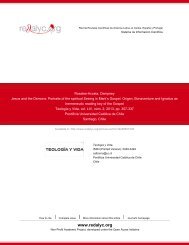A Key Concept in Modern Translation Theory - Redalyc
A Key Concept in Modern Translation Theory - Redalyc
A Key Concept in Modern Translation Theory - Redalyc
Create successful ePaper yourself
Turn your PDF publications into a flip-book with our unique Google optimized e-Paper software.
62 EQUIVALENCE REVISITED: A KEY CONCEPT IN MODERN TRANSLATION THEORY<br />
Other components which we labeled Conditions and Determ<strong>in</strong>ants are also important<br />
for understand<strong>in</strong>g language use from a communicative po<strong>in</strong>t of view: Competences<br />
(grammatical, communicative, textual, and cognitive), Socio-Psychological<br />
Characterization of Participants (social variables such as gender, age, role;<br />
psychological variables such as motivation, attention, <strong>in</strong>terest, memory), and Context<br />
(time and place of communication; historical, economic and social circumstances).<br />
At first this proposal was devised for analyz<strong>in</strong>g monol<strong>in</strong>gual communicative situations.<br />
Later we expanded it to <strong>in</strong>clude a bil<strong>in</strong>gual situation similar to the one that takes<br />
places <strong>in</strong> translation (cf. <strong>in</strong>fra Dynamic <strong>Translation</strong> Model). We underl<strong>in</strong>ed then<br />
that the text seemed to be a more suitable l<strong>in</strong>guistic unit of analysis than the sentence,<br />
among other th<strong>in</strong>gs, because: 1) It is a part of a communicative event that is<br />
contextualized and located <strong>in</strong> specific time and space coord<strong>in</strong>ates with real<br />
participants 2 and under real social, historical, and economic conditions, and therefore<br />
corresponds to the true nature of language that, by def<strong>in</strong>ition, is ‘contextualized’; 2)<br />
It is not an immanent l<strong>in</strong>guistic unit; its mean<strong>in</strong>g is determ<strong>in</strong>ed both by its <strong>in</strong>ner<br />
structure and by the external factors that surround it; 3) its extension cannot be<br />
established beforehand; it may be as short as a word or as long as a whole book as<br />
long as it satisfies the participants’ communicative needs (Bolaños 1995:57).<br />
Now it is clear that the communicative approach for the analysis of language<br />
use holds both <strong>in</strong> the case of monol<strong>in</strong>gual and bil<strong>in</strong>gual situations. By def<strong>in</strong>ition<br />
translation is a bil<strong>in</strong>gual situation that differs from bil<strong>in</strong>gualism, among other th<strong>in</strong>gs,<br />
because <strong>in</strong> translation speakers do not master the same language and need the<br />
help of a third party, i.e. the translator, that will re-establish the <strong>in</strong>terrupted<br />
communicative act. Another important difference <strong>in</strong> relation to what occurs <strong>in</strong><br />
bil<strong>in</strong>gual situations is that <strong>in</strong> translation the translator has to reproduce a content<br />
identical or at least very similar to what the sender has uttered <strong>in</strong> L1 (semantically<br />
and pragmatically determ<strong>in</strong>ed) but this time <strong>in</strong> L2. There is, so to speak, a conscious<br />
effort on the part of the translator to be faithful to the message <strong>in</strong>itially expressed<br />
<strong>in</strong> L1 <strong>in</strong> a process we can call of semantic and pragmatic ‘duplication’, which<br />
rarely occurs <strong>in</strong> traditional bil<strong>in</strong>gual situations where the flow of <strong>in</strong>formation<br />
cont<strong>in</strong>ues even if there is exchange of languages <strong>in</strong> the <strong>in</strong>teraction, <strong>in</strong> which case<br />
phenomena such as ‘code mix<strong>in</strong>g’ or ‘code switch<strong>in</strong>g’ may emerge.<br />
2<br />
In this respect L.L. Vochm<strong>in</strong>a (1987) dist<strong>in</strong>guishes an <strong>in</strong>ternal and an external speech situation.<br />
An <strong>in</strong>ternal psychological situation presents itself as a manifold set (structure) of circumstances<br />
reflected by the subject and which arise <strong>in</strong> the process of <strong>in</strong>teraction between the subject and his<br />
environment. The external speech situation corresponds to the set of circumstances which prompt<br />
the need to use speech for communicative purposes. The author clarifies that for man all situations<br />
<strong>in</strong> which he f<strong>in</strong>ds himself present themselves as l<strong>in</strong>guistic to the extent that speech participates <strong>in</strong><br />
the flux of almost all forms of human psychological activity. (p.16).
















